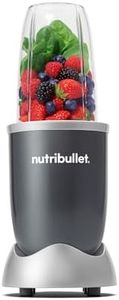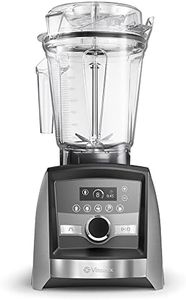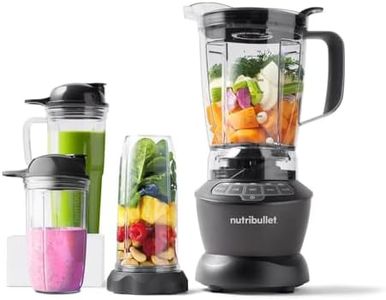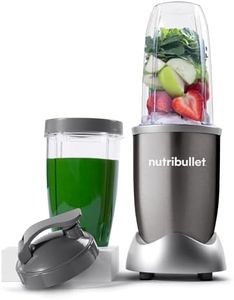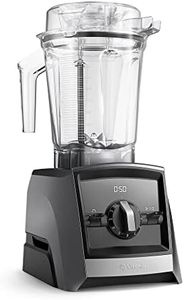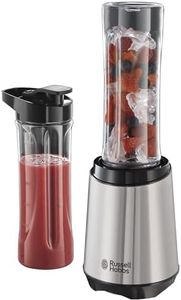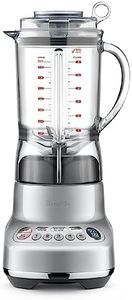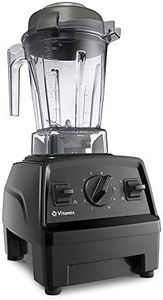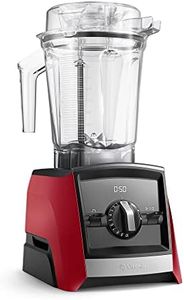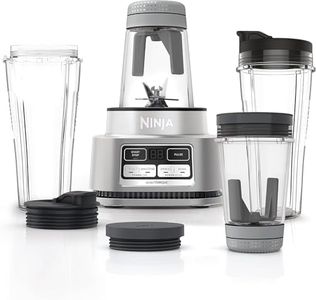We Use CookiesWe use cookies to enhance the security, performance,
functionality and for analytical and promotional activities. By continuing to browse this site you
are agreeing to our privacy policy
10 Best Smoothie Makers
From leading brands and best sellers available on the web.Buying Guide for the Best Smoothie Makers
Choosing the right smoothie maker can really improve your experience of making delicious and healthy drinks at home. The goal is to find a machine that matches your lifestyle, from how often you'll use it to the types of ingredients you prefer. Whether you want something quick for a single serving or a powerful blender for family-sized batches, understanding the key specs will help ensure you get the best fit for your needs.Power (Wattage)Power refers to the strength of the motor, usually measured in watts. Higher wattage means the blender can handle tougher ingredients like frozen fruit, nuts, and ice with ease, making smoother drinks. Low-wattage smoothie makers (around 200–400W) are suitable for simple fruit blends or soft ingredients; mid-range models (400–700W) can take on most frozen fruit and harder veggies; high-watt blenders (700W and above) are ideal for frequent use, tough ingredients, and extra-smooth textures. Your choice should depend on what you plan to blend most often—if you like fibrous greens or often add ice, opt for more power.
CapacityCapacity means how much liquid the container can hold, measured in liters or milliliters. Small, single-serve blenders (300–600ml) are perfect for people making drinks for themselves or on the go; medium sizes (600–1200ml) are better for two people or small families; large capacities (1.2L or more) suit families or anyone who likes to blend in bulk. To pick the right size, think about whether you'll be making one smoothie at a time or preparing larger batches for multiple servings.
Blade Quality and DesignBlades are the part that does the cutting and blending. High-quality stainless steel blades are more durable, resist rust, and stay sharp longer. Look for blade designs that are angled or multi-layered, as these blend ingredients more thoroughly. Simpler, small straight blades can work for soft fruits, but if you want to blend harder things or crush ice, opt for models with more robust, multi-pronged blades. If your recipes often include tough veggies or nuts, blade quality becomes especially important.
Ease of CleaningCleaning your smoothie maker should be simple, otherwise it might discourage frequent use. Some models have detachable blades and jars that are dishwasher-safe, making things much easier. Others require everything to be washed by hand, which can be time-consuming or tricky. If you want quick cleanup, look for blenders that specifically mention easy cleaning or dishwasher-safe parts, especially if you plan to use your blender regularly.
Speed Settings and ControlsSpeed settings let you control how fast or slow the blades spin, affecting how finely your ingredients are blended. Basic models may offer just one speed or a simple on/off function, which is fine for simple drinks. Models with two or more speeds—or even pulse options—provide more control over texture and blending, useful when you want either chunky or super-smooth results. If you plan to make varied recipes or care about texture, go for a smoothie maker with several speed options.
Portability and StorageThis refers to how easy it is to move or store your smoothie maker. Some smaller models have compact designs or come with travel cups, making them ideal for limited spaces or people who want to blend and go. Larger units may offer more power but will take up more countertop or storage space. Consider how much space you have at home, and whether you'll want a portable smoothie maker for use at work or the gym—if so, a compact, lightweight option will be best.

